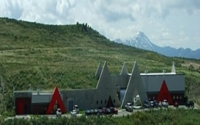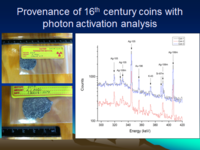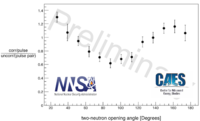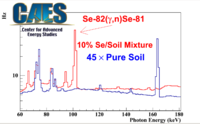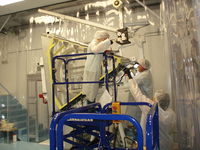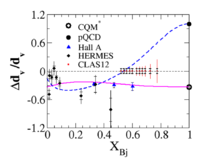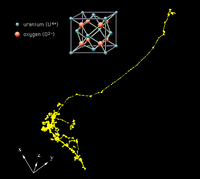Difference between revisions of "PhysWebPageBannerContent"
(→Se PAA) |
|||
| (46 intermediate revisions by the same user not shown) | |||
| Line 16: | Line 16: | ||
*radiation effects in materials and devices | *radiation effects in materials and devices | ||
*nuclear reactor fuel cycle physics | *nuclear reactor fuel cycle physics | ||
| − | |||
| − | |||
*fundamental nuclear and particle physics. | *fundamental nuclear and particle physics. | ||
| − | = | + | =The Idaho Accelerator Center (IAC)= |
| + | |||
| + | ==The Center== | ||
| + | |||
| + | The Idaho Accelerator Center (IAC) is a research facility operated by Idaho State University located in southeast Idaho. It provides opportunities for scientists and engineers from the University, the private sector, and national laboratories to utilize electron accelerators. It serves as a principal investigating conduit for nuclear physics applications research and development in materials science, biology, homeland, and national security. Student's from the Physics department are involved in all aspects of the center, from operating electron accelerators to performing experiments in nuclear physics applications. For more information go to iac.isu.edu. | ||
| + | |||
| + | |||
| + | [[File:IAC_11-21-16.png | 200 px]] | ||
| + | |||
| − | + | ==Photon Activation Analysis== | |
| + | |||
| + | Photon Activation Analysis is a "non-destructive" process of quantifying nuclear isotope concentrations by exciting a tiny fraction of the nuclei in a material of interest using photons in the MeV range. The photons used to irradiate these materials of interest are produced when electrons, accelerated by the Idaho Accelerator Center's Linacs, are impinged upon a radiator target, typically Tungsten, and undergo a bremsstrahlung interaction. Stable nuclei can become unstable if a photon "knocks out" either a proton or neutron. This unstable nucleus can emitt radiation in the form of photons as part of its decay process. A fingerprint unique to the specific nuclear isotope is constructed based on the energy of the observed photon and the half life of the isotope. An example of how these isotope signatures are used to determine the provenance of Gold coins is shown above. | ||
| − | |||
| + | [[File:PAA_GoldCoins_12-2-16.png| 200 px]] | ||
| − | = | + | ==2N Correlations== |
| + | This figure shows the opening angle distribution of two neutrons emitted in the photo-fission of U-238. Bremsstrahlung photons were generated by a 10.5 MeV electron beam impinging a 25 mm aluminum radiator at the Idaho Accelerator Center. Fission neutrons were defined as being in coincidence if they were detected within 150 nanoseconds of each other. This detection rate was normalized using a method that relies on the simultaneous measurement of the uncorrelated neutron emissions. While neutrons are emitted isotropically in the rest frame of the fission fragments, an angular dependence results from the kinematic boost that is caused by the recoiling fission fragments in the lab frame. This work was supported by both the [https://nnsa.energy.gov NNSA] and the [https://caesenergy.org CAES].. | ||
| − | |||
| + | [[File:2Ncorr_2018_5.png| 200 px]] | ||
| − | + | ==Se PAA== | |
| − | |||
| − | + | This project illustrates the use of a nuclear physics based technique, Photon Activation Analysis, to measure the concentration of nuclear isotopes in a material. | |
| − | + | The isotopic ratio of Se-82 to Se-76 has been observed to strongly vary in plant material as compared to other materials that would be present in the environment, such as soil. Anaerobic bacteria are believed to be responsible for affecting this ratio when they process selenates and selenites. As part of its mission to educate the next generation of scientists and engineers, the Center for Advanced Energy Studies (CAES) partially supported a student whose research was to determine the minimal detectable limit for observing Selenium. The histogram above represents the energy spectrum of photons emitted from two samples that were irradiated by bremsstrahlung photons having energies up to 36 MeV. A measurement of the Se-82 isotope in soil that has been doped with naturally occurring Selenium is made by observing the characteristic photons emitted by a Se-81 nucleus that results when a neutron is knocked out of a Se-82 nucleus. A measurement of un-doped soil, subjected to the same irradiation conditions, has been overlayed for comparison. The next step of this project would be to study the provenance of Selenium isotopic ratios in plant material. | |
| − | + | [[File:SeProv_2019.png| 200 px]] | |
| − | |||
| − | |||
| − | |||
| − | |||
| − | |||
| − | |||
| − | |||
| − | |||
| − | |||
| − | |||
| − | |||
| − | |||
| − | |||
| − | |||
| − | + | =JLab Projects= | |
| − | + | ==Detector Construction== | |
| − | |||
| − | |||
| − | |||
| − | |||
| − | |||
| − | |||
| − | |||
| − | |||
| − | |||
| − | |||
| + | [[File:092711_2CLAS12R1StringingBegins.jpg| 200 px]] | ||
| + | The above picture depicts the construction of particle detectors by the Idaho Accelerator Center and ISU's Department of Physics for the Department of Energy's Jefferson Lab facility in Newport New, Virginia. The particle detectors are wire chambers containing approximately 5,000, 30 micron diameter wires that are used to form gaseous cells which can detect the passage of ionizing particles. These detectors are now installed at Jefferson Lab in Newport News, Va and are being used to perform fundamental physics measurements designed to improve our understanding of the nucleon. | ||
| + | ==Nucleon's Fractional Down Quark Polarization== | ||
[[File:DeltadOverd_11-21-16.png| 200 px]] | [[File:DeltadOverd_11-21-16.png| 200 px]] | ||
| − | + | The contributions of a nucleon's constituents, quarks and gluons, to the spin of the nucleon has been a long standing question since the 1980s when it was first observed that quarks contribute less than 40%. | |
| + | The spin physics program at ISU is working to measure the contribution of a nucleon's down quarks to its spin. This is referred to as the down quark fractional polarization. Measurements of this quantity when compared with the standard theoretical description of quark interactions, Quantum Chromodynamics, have yet to indicate a transition from the observed negative values to the predicted positive value of unity. One goal of ISU's spin physics program is to determine the veracity of the theoretical prediction through a series of measurements with the expected precision shown above. | ||
| − | = | + | =INL Projects= |
| − | = | + | == Radiation Damage of Uranium Oxide== |
| − | |||
| − | + | [[File:UO2Damage_3-2-2019.png | 200 px]] | |
| + | Uranium Oxide is a common fuel used by nuclear reactors to generate electricity. Uranium releases energy when it splits into two ions, fission fragments, during a process known as fission. These ions are energetic enough to displace other Uranium and Oxygen atoms, causing damage the Uranium Oxide fuel, as the fission fragment ions traverse the fuel. As part of the Idaho National Lab's mission of ensuring safe sustainable energy, the lab conducts research to determine the effects of this damage on the safe use of the fuel. The image above illustrates a computer simulation by a physics graduate student of the damage done to uranium oxide by one such fission fragment, Xenon. | ||
Latest revision as of 18:12, 18 April 2019
Physics Department Mission /overview
Our mission: The mission of the Idaho State University Department of Physics is to pursue cutting edge research in both fundamental and applied physics, and train of the next generation of physical scientists, technicians, and educators.
- Overview
The Idaho State University Department of Physics is actively engaged in a variety of cutting edge research pursuits, all of which focus on the use of experimental nuclear physics techniques to address problems in both fundamental and applied science. Major efforts include:
- nuclear non-proliferation and homeland security
- radiation effects in materials and devices
- nuclear reactor fuel cycle physics
- fundamental nuclear and particle physics.
The Idaho Accelerator Center (IAC)
The Center
The Idaho Accelerator Center (IAC) is a research facility operated by Idaho State University located in southeast Idaho. It provides opportunities for scientists and engineers from the University, the private sector, and national laboratories to utilize electron accelerators. It serves as a principal investigating conduit for nuclear physics applications research and development in materials science, biology, homeland, and national security. Student's from the Physics department are involved in all aspects of the center, from operating electron accelerators to performing experiments in nuclear physics applications. For more information go to iac.isu.edu.
Photon Activation Analysis
Photon Activation Analysis is a "non-destructive" process of quantifying nuclear isotope concentrations by exciting a tiny fraction of the nuclei in a material of interest using photons in the MeV range. The photons used to irradiate these materials of interest are produced when electrons, accelerated by the Idaho Accelerator Center's Linacs, are impinged upon a radiator target, typically Tungsten, and undergo a bremsstrahlung interaction. Stable nuclei can become unstable if a photon "knocks out" either a proton or neutron. This unstable nucleus can emitt radiation in the form of photons as part of its decay process. A fingerprint unique to the specific nuclear isotope is constructed based on the energy of the observed photon and the half life of the isotope. An example of how these isotope signatures are used to determine the provenance of Gold coins is shown above.
2N Correlations
This figure shows the opening angle distribution of two neutrons emitted in the photo-fission of U-238. Bremsstrahlung photons were generated by a 10.5 MeV electron beam impinging a 25 mm aluminum radiator at the Idaho Accelerator Center. Fission neutrons were defined as being in coincidence if they were detected within 150 nanoseconds of each other. This detection rate was normalized using a method that relies on the simultaneous measurement of the uncorrelated neutron emissions. While neutrons are emitted isotropically in the rest frame of the fission fragments, an angular dependence results from the kinematic boost that is caused by the recoiling fission fragments in the lab frame. This work was supported by both the NNSA and the CAES..
Se PAA
This project illustrates the use of a nuclear physics based technique, Photon Activation Analysis, to measure the concentration of nuclear isotopes in a material. The isotopic ratio of Se-82 to Se-76 has been observed to strongly vary in plant material as compared to other materials that would be present in the environment, such as soil. Anaerobic bacteria are believed to be responsible for affecting this ratio when they process selenates and selenites. As part of its mission to educate the next generation of scientists and engineers, the Center for Advanced Energy Studies (CAES) partially supported a student whose research was to determine the minimal detectable limit for observing Selenium. The histogram above represents the energy spectrum of photons emitted from two samples that were irradiated by bremsstrahlung photons having energies up to 36 MeV. A measurement of the Se-82 isotope in soil that has been doped with naturally occurring Selenium is made by observing the characteristic photons emitted by a Se-81 nucleus that results when a neutron is knocked out of a Se-82 nucleus. A measurement of un-doped soil, subjected to the same irradiation conditions, has been overlayed for comparison. The next step of this project would be to study the provenance of Selenium isotopic ratios in plant material.
JLab Projects
Detector Construction
The above picture depicts the construction of particle detectors by the Idaho Accelerator Center and ISU's Department of Physics for the Department of Energy's Jefferson Lab facility in Newport New, Virginia. The particle detectors are wire chambers containing approximately 5,000, 30 micron diameter wires that are used to form gaseous cells which can detect the passage of ionizing particles. These detectors are now installed at Jefferson Lab in Newport News, Va and are being used to perform fundamental physics measurements designed to improve our understanding of the nucleon.
Nucleon's Fractional Down Quark Polarization
The contributions of a nucleon's constituents, quarks and gluons, to the spin of the nucleon has been a long standing question since the 1980s when it was first observed that quarks contribute less than 40%. The spin physics program at ISU is working to measure the contribution of a nucleon's down quarks to its spin. This is referred to as the down quark fractional polarization. Measurements of this quantity when compared with the standard theoretical description of quark interactions, Quantum Chromodynamics, have yet to indicate a transition from the observed negative values to the predicted positive value of unity. One goal of ISU's spin physics program is to determine the veracity of the theoretical prediction through a series of measurements with the expected precision shown above.
INL Projects
Radiation Damage of Uranium Oxide
Uranium Oxide is a common fuel used by nuclear reactors to generate electricity. Uranium releases energy when it splits into two ions, fission fragments, during a process known as fission. These ions are energetic enough to displace other Uranium and Oxygen atoms, causing damage the Uranium Oxide fuel, as the fission fragment ions traverse the fuel. As part of the Idaho National Lab's mission of ensuring safe sustainable energy, the lab conducts research to determine the effects of this damage on the safe use of the fuel. The image above illustrates a computer simulation by a physics graduate student of the damage done to uranium oxide by one such fission fragment, Xenon.
